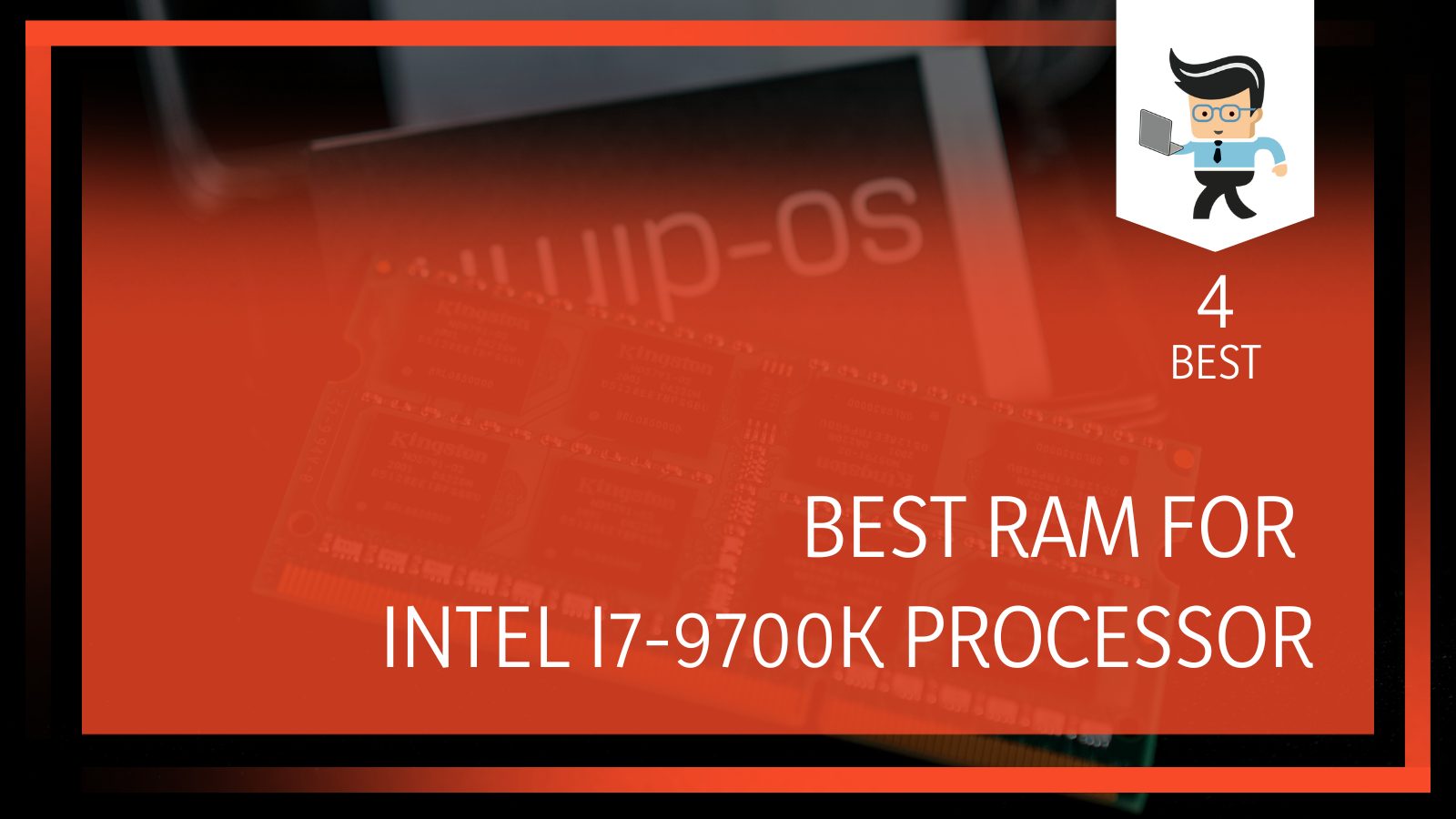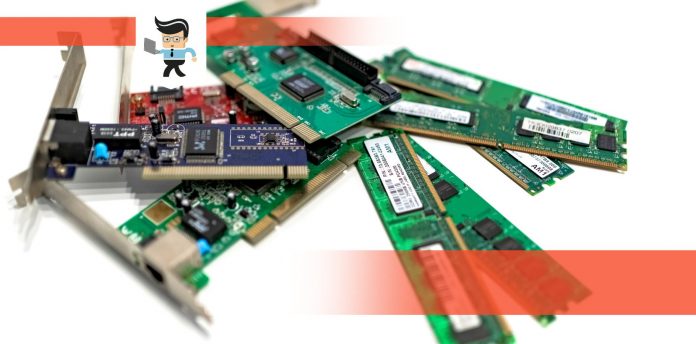RAM for i7 9700K processors needs to be DDR4 to make use of the full processing capability the Intel CPU has to offer.
I7 9700K DDR4 RAM can be of various speeds from 2133 MHz up to 3600 MHz (with overclocking).

Here, we review memory from Corsair, Crucial, HyperX and Silicon Power to find out which one is the best to pair with your Intel CPU.
Contents
Best RAM for i7-9700K
The four options reviewed below are Corsair Vengeance LPX 2x 8GB, the HyperX Predator Black 32 GB kit, Crucial Ballistix Sport LT, and the Silicon Power 2x 8GB. Of these, the HyperX Predator Black is the best offering for the i7 9700K. It has the capability for full RGB, assuming the motherboard has software support.
It is a nice feature, particularly when it seems that every internal component is designed to have colored lights on it, but certainly not the most important. It offers the largest memory capacity and the highest speeds, all in a two-stick format so that it can provide 32 GB of RAM even for motherboards that don’t have 4 DIMM slots.
1. Corsair Vengeance LPX
We could argue all day about DDR4 memory speeds vs DDR3 timings, but that argument loses any meaning if the platform you’re using only supports DDR4. The more relevant question for X99 motherboard owners is whether this DDR4-3200 kit is compelling enough for buyers not to choose the cheaper, if slower, DDR4-3000, 2800, or 2666 options also available from Corsair.
One of the key features of the Corsair Vengeance LPX is the integrated cooling fans that help keep the memory from overheating. While this is a nice touch, users who wanted the fans for either custom overclocks or future support of additional modules will find that the price difference between Corsair’s fan-equipped DDR4-3200 and its fan-free DDR4-2666 is less than the cost of the fans.
Given that the 3200 MHz max data rate is matched by lower-rated parts, yet better default timings provided a slight overall performance lead, how can we rate the value of Corsair’s Vengeance LPX DDR4-3200? Remembering that the included fans actually cost more than the price difference between it and the cheapest Corsair, it’s only a good value if you really want those fans.

Corsair’s quad-channel memory kit puts up solid performance numbers, but it is difficult for users to actually reach the reported 3200 speeds. Besides cooling the modules, included fans could be even more practical in builds that don’t have a fan over the CPU and cooling the rest of the components on the motherboard.
2. HyperX Predator Black 32 GB Kit
The Predator DDR4 RGB 32GB 2999 MHz from HyperX. At 2999 MHz, not the fastest, but this is a 32GB kit that can be tweaked over 3200 MHz easily. Like many components these days, it come with new configurable RGB implementation and runs XMP 2.0 memory profiles on Intel platforms as well. The second profile defaults to 2400 MHz when XMP isn’t running.
This memory is optimized for Intel platforms on Z170/Z270/X370 and X99/X299, obviously with four 4GB DIMMs, ideal for a dual and quad-channel setup.
HyperX shows us that a pair of 16GB dual-rank modules are at least as capable of delivering memory performance as a quartet of 8GB single-rank sticks with its Predator RGB 2x16GB DDR4-3200. This is key for most users of Mini ITX boards as well as some recent, larger Asus models, which only have two memory slots. This Predator RGB kit does the job nicely at its DDR4-3200 rating, with an asking price of about and leaves us with some interesting additional details, which we’ll get to below.
As the price of memory continues to slide, heavy multitaskers (or those who just aren’t good at keeping their browser tabs in check) may want to consider stepping past the 16GB mark. Determining the ideal minimum capacity to save money is difficult when so many programs are optimized to use a portion of the memory available. If you are in the market for DDR4 memory for gaming then it is probably worth it for you to go for the 32 GB of RAM to prevent any system slow downs.
Unfortunately, even though HyperX Predator Black is an RGB capable RAM, the manufacturer itself doesn’t offer an RGB utility, but instead relies on compatibility with major motherboard software such as Asus Aura, ASRock Polychrome RGB, Gigabyte RGB Fusion, and MSI Mystic Light.
If your board doesn’t support any of the RGB customization software, you’re stuck with the default rainbow pattern. The lighting of HyperX modules synchronizes to each adjacent module via an infrared interface, rather than relying on motherboard software for synchronization. So if you don’t have any compatible software, at least your modules’ lighting will remain visually in sync.

The HyperX Predator RGB 2x 16GB kit beat its four-DIMM predecessor in everything but overclocking, and we should expect that given that it has a higher XMP.
3. Crucial Ballistix Sport LT
Crucial’s Ballistix Sport memory is competitively priced DDR4 RAM and offers excellent performance out of the box. Its XMP profiles provide excellent speeds and no tuning is required to have good timings.
The Ballistix brand has been around now for fifteen years, and when you compare specs you may be surprised at how competitive Ballistix memory can be. In particular the 3200 MT/s with 16-18-18-36 is a top performer and a great value.
Beyond its default settings the Ballistix Sport LT 3200 memory is able to overclock up to 3466 MHz on AMD and 3600 MHz on Intel without any trouble. For those looking for a challenge, either using the XMP profile or try overclocking yourself will likely discover even better timings at these speeds.
The Sport LT DDR4-3200 kit from Crucial’s Ballistix Gaming brand is a decent value for those with compatible boards and processors, but may occasionally cause some problems if you have an Asus motherboard.
Builders need to enable XMP to allow a motherboard to automatically configure this kit’s higher-than-standard data rate and voltage, or else it you’ll be stuck running at DDR4-2400 C16. While this fallback is better than the DDR4-2133 of some competing kits, it’s much slower than the kit’s DDR4-3200 C16 rating.

Crucial is a brand that proudly uses Micron chips, one of the three largest chip manufacturers, in its RAM, and as such guarantees that it uses high quality components.
4. Silicon Power
For about the same price as competing solutions, Silicon Power’s XPower Turbine RGB offers a miniscule performance edge and cutting-edge aesthetics.
With the same type of lifetime limited warranty, similar pricing, and a performance edge so miniscule as to be inconsequential compared to its closest competition, buyers will probably pick their brand based on aesthetics. On that front, you should of course go with what you like, but the XPower Turbine makes a strong case for itself in the looks department, too.
Silicon Power put its toe in the door of the enthusiast DRAM market just a few months ago, so it will probably forgive us for thinking of it as a storage device firm. So new is its XPower Turbine RGB DDR4 that the firm didn’t even have boxes printed for its 2x 8GB kit when it sent our samples. The package inside still had space for two DIMMs however, and an updated photo from one of its sellers shows that the lack of dual-channel-kit packaging has since been resolved.
Buyers who suddenly find out too late that their boards can’t support that XMP will still get a reasonable DDR4-2666 configuration, and those who figure out too late that their Core i3-8350K is limited to DDR4-2400 should be pleased to note that the modules are also programed for that. While these fallback settings are all superior to the DDR4-2133 offered by some of Silicon Power’s competitors, we still think it best to figure out what your hardware can support before ordering new parts.
Silicon Power does not provide any download links for RGB software, but instead relies on applications provided by motherboard makers to support their own RGB lighting. Aura Sync, RGB Fusion, Mystic Light Sync and Polychrome Sync are all listed as compatible. Like the HyperX, this means if your motherboard doesn’t support any of these then you won’t be able to change the RGB settings on the memory.

With the performance race so close that nobody could likely be bothered to choose any of these kits based solely on that metric, aesthetics and pricing will likely drive their buying decision. We added our recently-tested DDR4-3200 C14 results to the performance baseline just to show how narrow the margins are for kits priced around 60% higher.
Conclusion
With over-priced fans, boasted speeds that are difficult to benchmark, and only a 16GB size, the Corsair memory falls short of the ideal i7 9700K RAM support.
Silicon Power is another 16 GB offering that doesn’t quite measure up to compatibility with i7 9700K specs. Though it lacks native software support for the RGB color suite, the HyperX Predator Black is the best memory reviewed here. With 32 GB capacity, it is least likely to be overwhelmed, even by demanding applications such as gaming.







